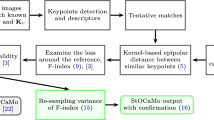Abstract
Using calibrated synchronised stereo cameras significantly simplifies multi-image 3D reconstruction. This is because they produce point clouds for each frame pair, which reduces multi-image 3D reconstruction to a relatively simple process of pose estimation followed by point cloud merging. There are several synchronized stereo cameras available on the market for this purpose, however a key problem is that they often come as fixed baseline units. This is a problem since the baseline that determines the range and resolution of the acquired 3D. This work deals with the fairly common scenario of trying to acquire a 3D reconstruction from a sequence of images, when the baseline of our camera is too small. Given such a sequence, in many cases it is possible to match each image with another in the sequence that has a more appropriate baseline. However is there still value in having calibrated stereo pairs then? Clearly not using the calibrated stereo pairs reduces the problem to a monocular 3D reconstruction problem, which is more complex with known issues such as scale ambiguity. This work attempts to solve the problem by proposing a guided stereo strategy that refines the coarse depth estimates from calibrated narrow stereo pairs with frames that are further away. Our experimental results are promising, since they show that this problem is solvable provided there are appropriate frames in the sequence to supplement the depth estimates from the original narrow stereo pairs.
Access this chapter
Tax calculation will be finalised at checkout
Purchases are for personal use only
Similar content being viewed by others
References
Bolles, R.C., Fischler, M.A.: A RANSAC-based approach to model fitting and its application to finding cylinders in range data. IJCAI 1981, 637–643 (1981)
Bouguet, J.Y., et al.: Pyramidal implementation of the affine lucas kanade feature tracker description of the algorithm. Intel Corporation 5(1–10), 4 (2001)
Bradski, G., Kaehler, A.: Learning OpenCV: Computer Vision with the OpenCV Library. O’Reilly Media, Inc., Sebastopol (2008)
Chan, Y.H., Delmas, P., Gimel’farb, G., Valkenburg, R.: Accurate 3D modelling by fusion of potentially reliable active range and passive stereo data. In: Jiang, X., Petkov, N. (eds.) CAIP 2009. LNCS, vol. 5702, pp. 848–855. Springer, Heidelberg (2009). https://doi.org/10.1007/978-3-642-03767-2_103
Fusiello, A., Trucco, E., Verri, A.: A compact algorithm for rectification of stereo pairs. Mach. Vis. Appl. 12(1), 16–22 (2000)
Geiger, A., Roser, M., Urtasun, R.: Efficient large-scale stereo matching. In: Kimmel, R., Klette, R., Sugimoto, A. (eds.) ACCV 2010. LNCS, vol. 6492, pp. 25–38. Springer, Heidelberg (2011). https://doi.org/10.1007/978-3-642-19315-6_3
Gimel’farb, G.: Probabilistic regularisation and symmetry in binocular dynamic programming stereo. Pattern Recogn. Lett. 23(4), 431–442 (2002)
Hannah, M.J.: Computer matching of areas in stereo images. Technical report, Stanford Univ CA Department of Computer Science (1974)
Hartley, R.I.: In defense of the eight-point algorithm. IEEE Trans. Pattern Anal. Mach. Intell. 19(6), 580–593 (1997)
Hirschmuller, H.: Accurate and efficient stereo processing by semi-global matching and mutual information. In: 2005 IEEE Computer Society Conference on Computer Vision and Pattern Recognition (CVPR 2005), vol. 2, pp. 807–814. IEEE (2005)
Kneip, L., Li, H., Seo, Y.: UPnP: an optimal O(n) solution to the absolute pose problem with universal applicability. In: Fleet, D., Pajdla, T., Schiele, B., Tuytelaars, T. (eds.) ECCV 2014. LNCS, vol. 8689, pp. 127–142. Springer, Cham (2014). https://doi.org/10.1007/978-3-319-10590-1_9
Konolige, K., Garage, W.: Sparse sparse bundle adjustment. In: BMVC, vol. 10, p. 102–1. Citeseer (2010)
Luong, Q.T., Faugeras, O.D.: The fundamental matrix: theory, algorithms, and stability analysis. Int. J. Comput. Vis. 17(1), 43–75 (1996)
Nguyen, M., Chan, Y.H., Delmas, P., Gimel’farb, G.: Symmetric dynamic programming stereo using block matching guidance. In: 2013 28th International Conference on Image and Vision Computing New Zealand (IVCNZ 2013), pp. 88–93. IEEE (2013)
Rosten, E., Drummond, T.: Machine learning for high-speed corner detection. In: Leonardis, A., Bischof, H., Pinz, A. (eds.) ECCV 2006. LNCS, vol. 3951, pp. 430–443. Springer, Heidelberg (2006). https://doi.org/10.1007/11744023_34
Roszkowski, M.: Overview of the major challenges in the wide baseline stereo vision. In: Photonics Applications in Astronomy, Communications, Industry, and High-Energy Physics Experiments 2011, vol. 8008, p. 800818. International Society for Optics and Photonics (2011)
Roth, H., Vona, M.: Moving volume kinectfusion. In: BMVC, vol. 20, pp. 1–11 (2012)
Taniai, T., Matsushita, Y., Sato, Y., Naemura, T.: Continuous 3D label stereo matching using local expansion moves. IEEE Trans. Pattern Anal. Mach. Intell. 40(11), 2725–2739 (2017)
Tao, T., Koo, J.C., Choi, H.R.: A fast block matching algorithm for stereo correspondence. In: 2008 IEEE Conference on Cybernetics and Intelligent Systems, pp. 38–41. IEEE (2008)
Author information
Authors and Affiliations
Corresponding author
Editor information
Editors and Affiliations
Rights and permissions
Copyright information
© 2020 Springer Nature Switzerland AG
About this paper
Cite this paper
Gee, T., Gimel’farb, G., Woodward, A., Ababou, R., Strozzi, A.G., Delmas, P. (2020). Guided Stereo to Improve Depth Resolution of a Small Baseline Stereo Camera Using an Image Sequence. In: Blanc-Talon, J., Delmas, P., Philips, W., Popescu, D., Scheunders, P. (eds) Advanced Concepts for Intelligent Vision Systems. ACIVS 2020. Lecture Notes in Computer Science(), vol 12002. Springer, Cham. https://doi.org/10.1007/978-3-030-40605-9_41
Download citation
DOI: https://doi.org/10.1007/978-3-030-40605-9_41
Published:
Publisher Name: Springer, Cham
Print ISBN: 978-3-030-40604-2
Online ISBN: 978-3-030-40605-9
eBook Packages: Computer ScienceComputer Science (R0)




